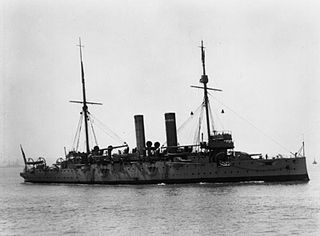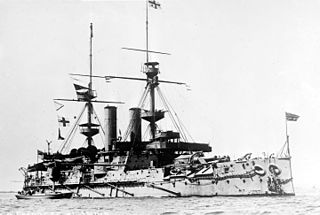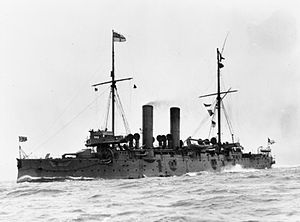
HMAS Psyche was a Pelorus-class protected cruiser built for the Royal Navy at the end of the 19th century. Initially operating on the North America and West Indies Station, the cruiser was transferred to the Australian Squadron in 1903, and remained there until the Royal Australian Navy (RAN) took over responsibility in 1913. After a stint in New Zealand waters and involvement in the Occupation of German Samoa, Psyche was paid off in 1915.

HMS Hawke, launched in 1891, was the seventh British warship to be named Hawke. She was an Edgar-class protected cruiser. In September 1911 the Hawke collided with the ocean liner RMS Olympic. The damage smashed the Hawke's bow and damaged the stern of the Olympic.
Admiral Robert Hamilton Anstruther, was a Royal Navy officer.

HMCS Rainbow was an Apollo-class protected cruiser built for Great Britain's Royal Navy as HMS Rainbow entering service in 1892. Rainbow saw time in Asian waters before being placed in reserve in 1909. In 1910 the cruiser was transferred to the Royal Canadian Navy for service on the west coast. At the outbreak of the First World War, Rainbow was the only major Canadian or British warship on the western coast of North America. Due to age, the cruiser was taken out of service in 1917 and sold for scrap in 1920 and broken up.

HMS Algerine was a Phoenix-class steel screw sloop of the Royal Navy. She was launched at Devonport in 1895, saw action in China during the Boxer Rebellion, and later served on the Pacific Station. She was stripped of her crew at Esquimalt in 1914, and transferred to the Royal Canadian Navy in 1917, being commissioned as HMCS Algerine. She was sold as a salvage vessel in 1919 and wrecked in 1923.

HMS Endymion was a first-class protected cruiser of the Edgar class. She served in China during the Boxer Rebellion and later in the First World War, and was sold in 1920.

HMS Grafton was a first class cruiser of the Edgar class, launched in 1892. She served in colonial service and in the First World War. Grafton survived the war and was broken up in the 1920s.

HMS Amphitrite was a ship of the Diadem-class of protected cruisers in the Royal Navy, which served in the First World War.

HMS Europa was a ship of the Diadem-class protected cruisers in the Royal Navy. She was built by J&G Thompson of Clydebank and launched on 20 March 1897.

HMS Terrible was the second and last of the Powerful-class protected cruisers built for the Royal Navy (RN) in the 1890s. She served on the China Station and provided landing parties and guns which participated in the Siege and Relief of Ladysmith in the Second Boer War in South Africa. A few months later she did much the same thing to help suppress the Boxer Rebellion in China. During this time, her captain was Percy Scott who trained his crew to a high standard in gunnery and had his training methods adopted by the entire Royal Navy.

HMS Aurora was one of seven Orlando-class armoured cruisers built for the Royal Navy in the mid-1880s. The ship spent a brief time in reserve before she was assigned to the Channel Squadron for two years in 1890. In 1893 Aurora became a coast guard ship in Ireland for two years before she was placed in reserve again. The ship recommissioned in 1899 for service on the China Station and some of her crew participated in the Battle of Tientsin in 1900 during the Boxer Rebellion. Aurora returned home two years later and was again reduced to reserve. She was taken out of service in 1905 and sold for scrap on 2 October 1907.

HMS Empress of India was one of seven Royal Sovereign-class pre-dreadnought battleships built for the Royal Navy during the 1890s. The ship was commissioned in 1893 and served as the flagship of the second-in-command of the Channel Fleet for two years. She was transferred to the Mediterranean Fleet in 1897, during which time Empress of India was assigned to the International Squadron blockading Crete during the uprising there. She returned home in 1901 and was briefly assigned as a coast guard ship in Ireland before she became the second flagship of the Home Fleet. The ship was reduced to reserve in 1905 and accidentally collided with the submarine HMS A10 the following year. Empress of India was taken out of service in early 1912 and accidentally struck a German sailing ship while under tow. She was sunk as a target ship in 1913.

HMS Barfleur was the second and last of the Centurion-class pre-dreadnought battleships built for the Royal Navy in the 1890s. Intended for service abroad, they exchanged heavy armour and a powerful armament for high speed and long range to counter the foreign armoured cruisers then being built as commerce raiders and were rated as second-class battleships.

HMS Amphion was a second-class cruiser of the Leander class which served with the Royal Navy. She was built at Pembroke Dockyard, being laid down in 1881, launched in 1883, and completed in financial year 1885–86, and then lay in ordinary at Devonport. She was commissioned for the 1887 and 1888 annual manoeuvres. She was recommissioned in December 1888. served in the Pacific until 1890, in the Mediterranean from 1890 to 1895, in ordinary in Devonport from 1895 to 1897 and in the Pacific once more from 1897 to 1904, having a refit in 1900.
HMS Otter was a Vickers three-funnel, 30-knot destroyer ordered by the Royal Navy under the 1895–1896 Naval Estimates. She was the fourth ship to carry this name since it was introduced in 1782 for a fire ship, sold in 1801.

HMS Talbot was an Eclipse-class protected cruiser built for the Royal Navy in the mid-1890s.

The Phoenix class was a two-ship class of 6-gun screw steel sloops built for the Royal Navy in 1895. Both ships participated in the suppression of the Boxer Rebellion, but Phoenix was destroyed in a typhoon while alongside in Hong Kong in 1906. Algerine became a depot ship at Esquimalt, was sold in 1919, and was finally wrecked in 1923.

HMS Astraea was an Astraea-class second class cruiser of the Royal Navy. She was built towards the end of the nineteenth century, and survived to serve in the First World War.
Admiral Sir James Andrew Thomas Bruce, KCMG was an officer in the Royal Navy, who was second in command of the British fleet on the China Station during the Boxer Rebellion.

HMS Mutine was a Condor-class sloop of the Royal Navy. Mutine was launched on 1 March 1900. While being delivered from Birkenhead to Portsmouth an accident in Mutine's boiler rooms caused some loss of life and gave her a name as an unlucky ship before her career even began. She served on the China Station, then the Australia Station between December 1903 and February 1905 and later became a survey ship, surviving until 1932 as a Royal Naval Volunteer Reserve drill ship, the last of her class to be sold.


















